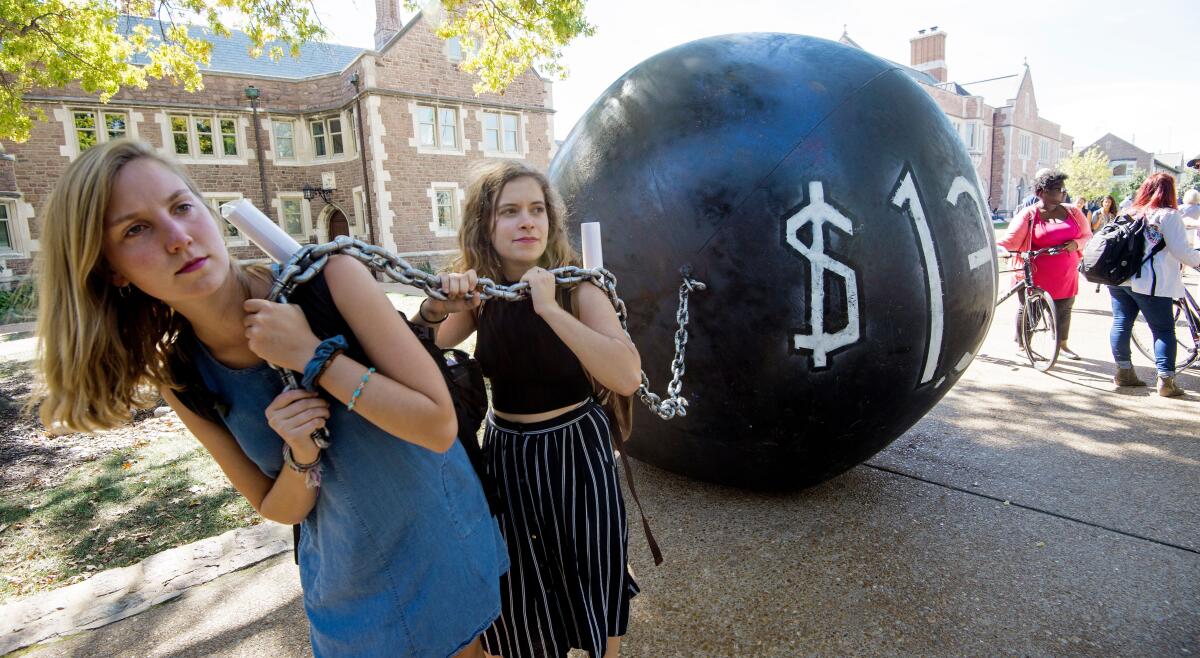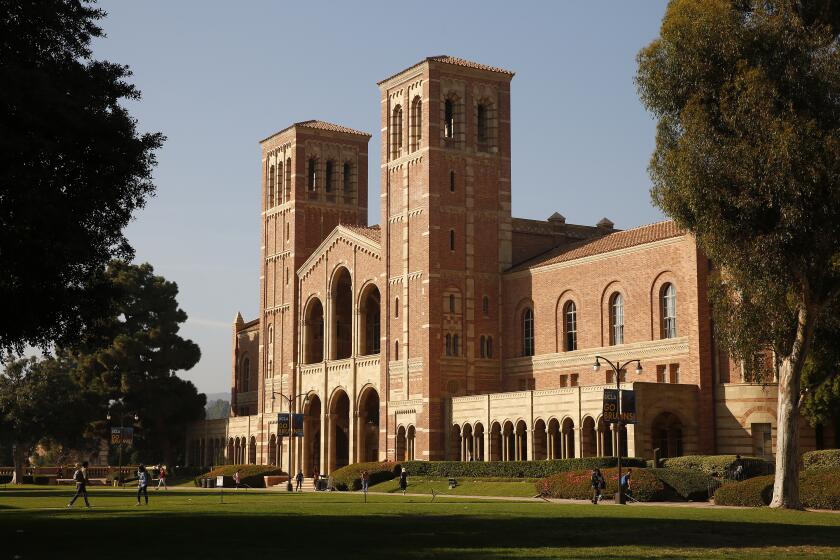Column: Student debt relief might cost $420 billion. That’s a bargain

The Congressional Budget Office has released its long-awaited estimate of the cost of President Biden’s student debt relief program, and as expected, it looks like a big number: $420 billion.
In its raw form, the figure evokes the line often attributed (perhaps apocryphally) to the late Sen. Everett Dirksen (R-Ill.) about “a billion here, a billion there, and pretty soon you’re talking real money.”
Unsurprisingly, conservatives have reacted with horror. “Debt cancellation is too costly, CBO confirms,” thundered the Committee for a Responsible Federal Budget, a leading spokesfront for the billionaire hedge fund owner class.
For many borrowers in income-driven repayment plans, a portion of the amounts canceled through executive action would eventually be forgiven anyway.
— Congressional Budget Office
A couple of points about this.
To begin with, the CBO “confirmed” nothing of the kind. Nowhere in its analysis does the suggestion appear that the program would be “too costly”: That’s the CRFB’s imagination.
Get the latest from Michael Hiltzik
Commentary on economics and more from a Pulitzer Prize winner.
You may occasionally receive promotional content from the Los Angeles Times.
Nor would one expect any such value judgment from the CBO, which sedulously adheres to its duty of analysis, devoid of tendentious commentary.
Second, the CBO’s estimate is of the present-value cost of student debt relief over 30 years. It’s a fair bet that you won’t find that qualifier in any of the conservative or Republican attacks on Biden’s plan. It certainly appears nowhere in the CRFB’s statement.
Instead, the right-wing think tank writes as if the whole $420 billion would be coming due all at once. “With inflation at a 40-year high ... ,” the CRFB writes, “we shouldn’t be adding to deficits.” Does the CRFB believe that inflation will remain at a 40-year high for the next three decades? If so, it stands alone.
Let’s put the CBO’s analysis in context.
Who paid for the college education for GOP critics of Biden’s student loan relief? The taxpayers, that’s who.
Remember that Biden’s plan calls for canceling $10,000 in outstanding debt for borrowers with incomes below $125,000, and $20,000 in debt for lower-income borrowers receiving federal Pell Grants to fund their college or university studies. Biden also extended the suspension of interest accruals and required payments on federal student debt through the end of this year; the suspension had been scheduled to end on Sept. 1.
The $420-billion cost ($400 billion in present value due to the debt cancellation and $20 billion from the payment suspension) comes to an average of $15 billion a year over 30 years. As the CBO observes, the cost is front-loaded, with more in the first 10 or 15 years of debt relief.
In 2023, the CBO estimates, the cost would come to about $15.76 billion, or 0.08% of U.S. gross domestic product, which is estimated to be about $19.7 trillion. That one-year cost would be the equivalent of a quarter of 1% of the federal budget, which the White House estimates will be about $6.01 trillion.
Nor will the relief plan have a significant effect on the annual federal deficit, which the CBO expects to amount to 3.75% of GDP next year; adding the one-year cost of debt relief would raise the deficit ratio to 3.83% of GDP.
It’s proper to observe that the costs of student debt relief aren’t actually outlays of cash by the federal government. They’re revenues that the government might have expected through repayments, but won’t receive because of Biden’s plan.
As it happens, the CBO reckons that the government wouldn’t receive some of those payments in any case. That’s because many borrowers are in income-driven repayment plans, through which they repay only a set percentage of their annual income (typically 10%), with the balance of their debt forgiven after 20 to 25 years.
“For many borrowers in income-driven repayment plans,” the CBO observed, “a portion of the amounts canceled through executive action would eventually be forgiven anyway.” The CBO didn’t estimate how much that forgiveness would come to.
The CBO did open a window on the impact of the Biden plan on the 43 million borrowers currently carrying $1.6 trillion in federal student loans. The Biden plan would cancel about $430 billion of that debt. Of the borrowers, 95% will meet the income eligibility standards for cancellation, the CBO calculated, 90% of them will apply for debt relief, and 45% will see their entire debt canceled.
Is canceling student debt inflationary? No, it’s good for the economy.
Whether one sees $420 billion in present value as a lot or a little to spend on the goal of relieving several generations of students of what is, for many of them, a crushing burden, depends on one’s general economic and political vantage points.
But to call it an “outrageous cost,” as the CRFB does, suggests that the billionaire-funded think tank has a warped standard for outrage. If $420 billion over 30 years is “outrageous,” what should we say about the preferential tax on capital gains, which almost exclusively benefits the rich and will cost the government nearly $1.8 trillion over the next 10 years alone?
For further context, consider that the $15-billion average annual cost of student loan relief is the equivalent of about one week of spending by the Pentagon, not a little of which is wasted.
The CBO analysis makes clear that much of the conservative pushback against the student loan relief plan is balderdash. For instance, at $15 billion a year, the relief wouldn’t have a measurable impact on inflation.
The CBO’s estimate that 95% of borrowers have less than $125,000 in annual income — and that two-thirds of them have received a Pell Grant for low-income students — refutes the idea that a significant portion of the relief will go to the affluent.
When you take those criticisms away, you’re left with the basic rationale for the program: Debt relief will give its beneficiaries a greater opportunity to participate in the American economy. That’s good for them, and good for the economy.
More to Read
Get the latest from Michael Hiltzik
Commentary on economics and more from a Pulitzer Prize winner.
You may occasionally receive promotional content from the Los Angeles Times.













